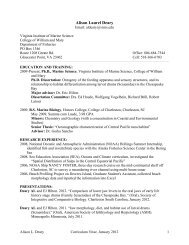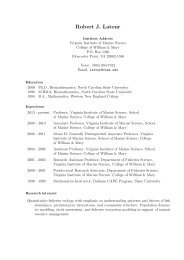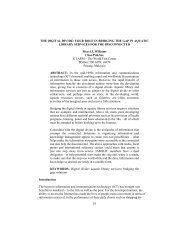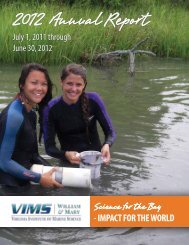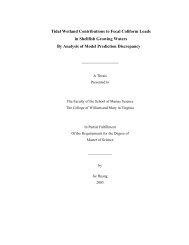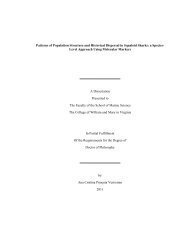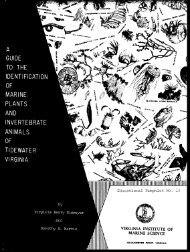Behaviors of the pelagic red crab Pleuroncodes planipes observed ...
Behaviors of the pelagic red crab Pleuroncodes planipes observed ...
Behaviors of the pelagic red crab Pleuroncodes planipes observed ...
Create successful ePaper yourself
Turn your PDF publications into a flip-book with our unique Google optimized e-Paper software.
<strong>Behaviors</strong> <strong>of</strong> <strong>Pleuroncodes</strong> <strong>planipes</strong> 75ing <strong>crab</strong>. This type <strong>of</strong> gesturing usually resultedin <strong>the</strong> approaching <strong>crab</strong> changing directions.Sparring between males also occur<strong>red</strong> whenone male approached a female that was beingguarded by ano<strong>the</strong>r male ei<strong>the</strong>r prior to or justafter mating.DISCUSSION<strong>Pleuroncodes</strong> <strong>planipes</strong> have been describedas dividing <strong>the</strong>ir time between <strong>the</strong> benthos during<strong>the</strong> day and <strong>the</strong> epi<strong>pelagic</strong> zone to feed atnight (Boyd, 1962; Blackburn, 1977). However,<strong>the</strong> <strong>crab</strong>s were also found in large surfaceswarms during <strong>the</strong> day (Boyd, 1967; Aurioles-Gamboa, 1992) and are conside<strong>red</strong> <strong>the</strong> mostabundant nektonic organism <strong>of</strong>f sou<strong>the</strong>rn BajaCalifornia waters (Blackburn & Thorn, 1974).When <strong>the</strong> <strong>crab</strong>s were initially collected forthis study, <strong>the</strong>y were small (standard carapacelength < 32 mm), which corresponded with <strong>the</strong><strong>pelagic</strong> phase <strong>of</strong> <strong>the</strong>ir life cycle (Boyd, 1967);<strong>the</strong>y floated frequently and could not walk wellwhen stranded on <strong>the</strong> beaches. However, afterbeing introduced into <strong>the</strong> aquarium with numeroussurfaces to rest on, P. <strong>planipes</strong> began toexhibit more benthic behaviors. Once in captivity,<strong>the</strong> <strong>red</strong> <strong>crab</strong>s seemed to grow quickly andmany <strong>of</strong> those collected in April 2002 moltedafter only a month in <strong>the</strong> aquarium. Over time,<strong>the</strong>y adopted a mainly benthic lifestyle withintermittent periods <strong>of</strong> swimming, hovering andpassive sinking. This change in <strong>the</strong> <strong>red</strong> <strong>crab</strong>s’behavior from planktonic to mostly benthic wasalso <strong>observed</strong> <strong>of</strong> <strong>the</strong> captive <strong>crab</strong>s kept in anaquarium by Boyd (1962).Boyd (1967) described <strong>red</strong> <strong>crab</strong>s as voraciouseaters, with an omnivorous diet. This hasbeen supported by observations in <strong>the</strong> watercolumn <strong>of</strong>f sou<strong>the</strong>rn Baja California where <strong>red</strong><strong>crab</strong>s feed on phytoplankton and zooplankton(Longhurst, 1967) and even ingest particulateorganic matter when on <strong>the</strong> ocean bottom(Aurioles-Gamboa & Pérez-Flores, 1997). Red<strong>crab</strong>s moved <strong>the</strong>ir maxillipeds and <strong>the</strong>n <strong>the</strong>irmandibular palps every few seconds ingestingfood particles or moving water towards<strong>the</strong> mouth. Similar limb motions have been<strong>observed</strong> in palinurid lobsters, and many o<strong>the</strong>rmalacostracan crustaceans, where <strong>the</strong>y flick<strong>the</strong>ir antennules and mouthpart appendages andcreate convective flows <strong>of</strong> water that facilitate<strong>the</strong> tracking <strong>of</strong> <strong>the</strong> chemical signatures <strong>of</strong> food(Goldman & Patek, 2002).Additional limb motion, possibly related t<strong>of</strong>eeding behaviors, occur<strong>red</strong> frequently when<strong>the</strong> <strong>red</strong> <strong>crab</strong>s groomed <strong>the</strong>mselves. In contrastto some species <strong>of</strong> brachyuran spider <strong>crab</strong>s(Macropodia spp.) that attach pieces <strong>of</strong> algaeto <strong>the</strong>ir carapace or those that have modifiedpereopods to hold sponges to <strong>the</strong>ir bodies forcamouflage (Dromidia spp.) (Warner, 1977;Ross, 1983), <strong>Pleuroncodes</strong> <strong>planipes</strong> spent timemeticulously cleaning <strong>the</strong>ir exoskeleton <strong>of</strong> particlesthat had adhe<strong>red</strong> to it with <strong>the</strong>ir chelatefifth pereopods. Bauer (1989) listed numeroussources <strong>of</strong> fouling particles, such as sediment,unicellular algae, and parasites that can accumulateon <strong>the</strong> exoskeleton <strong>of</strong> aquatic crustaceansand negatively impact normal functions<strong>of</strong> sensory, respiratory and locomotory behaviors.Accumulated debris on <strong>the</strong> exoskeleton <strong>of</strong><strong>the</strong> <strong>red</strong> <strong>crab</strong> may be akin to fouling organismson <strong>the</strong> hull <strong>of</strong> a ship (Bauer, 1989). If <strong>the</strong> exoskeletonwas not frequently cleaned betweenmolts, <strong>the</strong> fouling particles would build up,eventually modifying <strong>the</strong> natural streamlining<strong>of</strong> <strong>the</strong> <strong>red</strong> <strong>crab</strong>’s carapace, pereopods, abdomenand tail-fan with <strong>the</strong>ir associated setae.Maintaining <strong>the</strong> exoskeleton appea<strong>red</strong> to be animportant function that may enhance <strong>the</strong> <strong>pelagic</strong><strong>red</strong> <strong>crab</strong>s’ swimming efficiency by <strong>red</strong>ucing<strong>the</strong> drag along <strong>the</strong> body (Tulipani, 2005).Fur<strong>the</strong>rmore, <strong>the</strong>se accumulated particles werea food source for <strong>the</strong> <strong>red</strong> <strong>crab</strong>s.When <strong>red</strong> <strong>crab</strong>s interacted with each o<strong>the</strong>rin <strong>the</strong> aquarium, <strong>the</strong>y prefer<strong>red</strong> keeping somedistance between each o<strong>the</strong>r, a common behavioramong <strong>crab</strong>s which allows <strong>the</strong>m to avoidone ano<strong>the</strong>r (Warner, 1977; Salmon & Hyatt,1983). When distance was not maintained, agonisticbehaviors (gesturing with chelipeds withdactyls abducted or fighting) and avoidancebehaviors (brief tail-flips away) were <strong>observed</strong><strong>of</strong> <strong>red</strong> <strong>crab</strong>s and have been similarly describedfor o<strong>the</strong>r decapod <strong>crab</strong> species (Pilumnus sp.,



